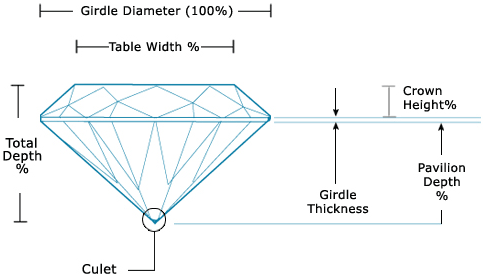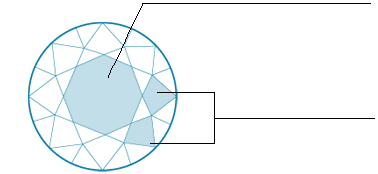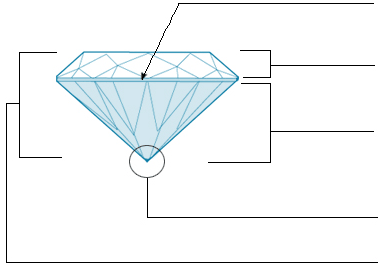THE 4 C'S
CUT
Math is the determining factor in deciding the cut of a diamond. Every diamond is cut according to an exact mathematical formula. The most common cut, the round brilliant, has 58 facets, or small, flat, polished planes designed to yield the maximum amount of light to be reflected back to the viewer.
This reflection, known as brilliance, is an extremely important factor in evaluating the quality of a diamond. A poorly cut diamond will actually lose light and appear dull. The two most common mistakes in cutting a diamond are:

Too Deep:
Light escapes out the sides causing the diamond to appear dark and dull.

Too Shallow: Light is lost out the bottom causing the diamond to lose brilliance.
Proportions
A diamond's proportions refer to the Table Diameter, the Pavilion Depth, the Crown Angle, the Girdle Thickness and the Culet Size. The calculations of these factors are confusing and involved, requiring complex mathematical formulations and expensive equipment to measure and calculate.

Diamond Anatomy

Table
The topmost and largest facet of a diamond
Facets
One of the small, flat surfaces that is polished on a gemstone to increase brilliance and beauty

Girdle
A narrow band which runs around the circumference of the diamond
Crown
The top portion of the diamond which extends from the girdle to the corner of the table
Pavilion
The bottom part of a diamond which covers the area between the girdle and culet
Culet
The bottom most part of a diamond
Depth
The height of a diamond
A diamonds brilliance is affected by:
a) The depth of the diamond compared to its diameter
b) The diameter of the table compared to the diameter of the diamond
Polish and Symmetry
Polish
All the facets of a diamond are not equally hard, it is therefore possible to polish and shape a diamond.
The polish rating refers to the minute lines left on the diamond after the polishing process; these lines are straight in appearance. After cutting, each diamond facet is polished to improve the appearance and light return and so it is important to note all facets when considering this grade. If one of these facets has a burn mark from the polishing process then this will significantly affect the rating even though this may be unnoticeable when the diamond is set. A polish grade of good or higher will normally mean that no polish lines are visible to the unaided eye. However, below this rating polish lines may be visible, significantly reducing the overall brilliance of the diamond.
Symmetry
Symmetry refers to the alignment of a diamond’s facets and its overall fire and brilliance.. The light bounces around inside a diamond reflecting off the facets, if the facets are not properly aligned then the light will not be returned through the top of the diamond into the eye*. The symmetry of a diamond has an important influence on the overall appearance of the diamond, for example if a round diamond has poor symmetry then the overall appearance will not be round as the different sides of the diamond will not look the same.
* The term Hearts and Arrows is used to describe the visual effect achieved in a round diamond with perfect symmetry and angles, once this type of diamond is set the hearts and arrows pattern will not be visible.
Diamond Pricing
Whilst the Color, Clarity and Carat of a diamond are a good indication of the overall appearance of the diamond you will receive, they will often not be the final determining factors in the brilliance of the diamond and therefore the price of the diamond. Being that 98% of a diamond’s brilliance is controlled by the quality of its Cut those interested in the most brilliant diamond should be aware of the diamond Cut. The industry has made this synonymous with the shape of the diamond but these are very different. When we refer to a diamond Cut we are in reality referring to the compilation of three main factors, these are the proportions, polish and symmetry of the facets of the diamond. It is important to understand these terms when comparing what may appear to be equal diamonds in terms of their Color, Clarity and Carat weight with significant price differences:
Classification of Cut
All loose diamonds offered for sale are independently certified by recognized grading laboratories.
It should however be noted that the different laboratories each use slightly different criteria with which to grade diamonds, and for this reason the same diamond could be graded by three independent laboratories and come back with three slightly differing reports.
We understand that this can make it very hard to compare diamonds that have been graded by different laboratories, and in recognition of this fact, our experienced in-house experts assign each diamond with a grade based upon current market trends and standards.
COLOR
The most popular Color for Diamonds is "white" or colorless. Whilst Diamonds come in every Color of the spectrum, for "white" Diamonds truecolorless examples are extremely rare and therefore demand the highest value.
Regular "white" Diamonds are graded by Color and are given letter designations dependant upon how far they deviate from the purest "white."
Put simply, just a small amount of Color can diminish a stone's "brilliance & fire" and therefore ultimately negatively effect the overall value of any given Diamond.
Diamonds deemed to be truly colorless are awarded the Color grading of D. Color grading then continues down through the alphabet, with each letter designating a slightly yellower tint. The progression is:
D : Absolutely colorless. The highest color grade, which is extremely rare.
E : Colorless. These are extremely rare and sought after. Only minute traces of color can be detected by an expert gemologist using a loupe.
F : Colorless. Significant quality stone. Slight color detected by an expert gemologist, but still considered a "colorless" grade.
G-H : Near-colorless. Color noticeable when compared to diamonds of better grades, but these grades offer excellent value.
I-J : These can be excellent value stones. I-J Color Diamonds are almost colorless with only a slightly detectable yellow tint, often making them offer excellent value for money.
K-M: Diamonds with color grades of K through M may appear faintly yellow, brown, or gray in their settings
Recommendation: The best way to determine the true Color of a diamond is by looking at it against a white surface.
CLARITY
A diamond's clarity is affected by any detectable external irregularities and internal imperfections created by nature when the diamond was formed.
Imperfections such as spots or lines are called inclusions. The less inclusions, the higher the clarity and thus, the greater brilliance and ultimately, value.
Inclusions can interfere with the passage of light through the stone, diminishing the sparkle and value of the diamond.
According to the quality analysis system of the Gemological Institute of America, clarity is graded on a scale ranging from internally flawless (IF) to included (I).
To be graded flawless, a diamond must have no inclusions visible to a trained eye under a 10x magnification in good light.
The quality analysis system is as follows:
FL, IF Diamonds:
These diamonds are the most rare and most expensive. These diamonds have been graded as (FL) Flawless: no internal or external flaws. (IF) Internally Flawless: No internal flaws.
VVS1, VVS2 Diamonds:
A superior quality diamond. Very, Very Slightly Included: Very difficult to see inclusions under 10x magnification.
VS1, VS2 Diamonds:
A lesser quality than the VVS1 or VVS2 grades. Very Slightly Included: Inclusions are not typically visible to the unaided eye, but are viewable at 10x magnification.
SI1, SI2 and SI3 Diamonds:
When combined with other factors, these grades represent good value. Slightly Included: Inclusions are visible under 10x magnification, and may be visible with the unaided eye.
I1, I2, I3 Diamonds:
These diamonds contain inclusions that are visible to the naked eye. I grade diamonds are often purchased by customers seeking the largest stone possible for their money and these individuals are therefore not concerned about inclusions. However, our website does not offer I3 grade diamonds.
CARAT
A Carat is the unit of measurement for a diamond's weight - it is equal to 200 milligrams, and there are 142 Carats to an ounce. Carats are referenced by dividing them into points - there are 100 points in a Carat.
A half Carat diamond may be referred to as a 50-point stone (about 100 milligrams). Because large diamonds are rarer, they generally have a greater value per Carat than smaller sized stones.
This word for the measurement of a diamond's weight Carat - is derived from the carob seeds that were used to balance scales in ancient times.
Today, it is important to evaluate all of the factors (all the C’s) and not just size. A large sized diamond with poor clarity, color and cut does not have the value of many smaller stones. C’s like clarity, cut and color determine the visual brilliance of the jewelry.
